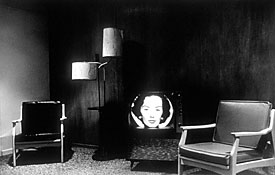 |
|
Photo courtesy of the Center for Creative Photography
|
"Philadelphia, 1968," is part of Lee Friedlander's "The Little Screens" exhibition at the Center for Creative Photography. The exhibition opens Saturday and runs until Dec. 8.
|
|
By Lisa Schumaier
Arizona Daily Wildcat
Thursday October 3, 2002
You enter a vacant room and the only presence is on the television screen. No one is on the couch flipping through channels, but we do not go to switch off the picture. It is continuously updated like the digital clock by your bedside; you would not unplug it simply because you were not constantly looking at the time.
This image creates a mood, and for Lee Friedlander, the entire disposition of the 1960s. His exhibit is called "The Little Screens." It features photographs of icons that appeared on television during that time, but the screen is given a context ¸ human lives.
Born in Aberdeen, Wash, in 1934, Friedlander was first exposed to photography at the age of 14. The artist rigorously studied the subject in Los Angeles before he journeyed to New York, where he received his first commercial assignment. Portraits of famous jazz musicians composed his early career, and numerous other photographs of his were published in leading magazines of the time.
Karen Jenkins, assistant curator at the Center for Creative Photography, said, "He photographed urban space. They were dense spaces with street signs, cars and people." By the 1960s, Friedlander was regarded as a remarkable photographer.
"The Little Screens" was first displayed at the Fraenkel Gallery in San Francisco. The photographer traveled throughout the states to capture tiny fragments of time and light that are representative of the uniquely American landscape of an isolationist culture.
"He stayed in motels and hotels as he traveled and these images appeared," Jenkins said. "It began as a natural product of life on the road."
Able to take the mundane interior landscape of our living space, his images bring truth to these individual scenes of daily lives. For the first time, we notice the lone undressed hanger that dangles from a cracked closet door, or the retentive way the desk is organized, an empty waste basket or the sinister shadows cast from the unnatural light.
As onlookers, we are aware of an absurd and surreal existence.
Walker Evans, a critic for Harper's Bazaar, called them, "deft, witty, spanking little poems of hate." But Jenkins sees something different.
"There is great forward social content, but also the photographer continually points out his role as image-maker," Jenkins said. "In the pictures, you can see his feet or reflection ¸ he was interested in images within images."
Through Friedlander's photographs, we see portraits of our own living rooms. Individual portraits, where the face does not express fulfillment and the gaze is distant with unidentified regret. However, he does not show the age of the 1960s by photographing the people.
Humans are purposely absent from his images.
He captures the dissonance of the era in the spaces that housed this feeling ¸ it is a living room decorated with the patterns of angst, and the main occupant is the latest star on morning, daytime and nightly TV.
Though the photographs reveal an intimate portrayal of a very specific time, his concept thrives today. Insinuating that television is symbolic of void, the era of television is still reminiscent of our lack of human connection, our isolation and the inability to separate ourselves from a contrived scene that is taking place in our lives though we are not a part of it.
Television is not even an object in the corner of our houses anymore, but is huge and centered on the main wall facing our sitting areas.
Gathering with friends around the coffee table takes place during commercials.
Since its birth, television has become a background family member.
We are not always solely attentive to the images and information it has to present, but more so to the comfort that it brings to our, at times, lonely lives.
And for many, the noise is even necessary for sleep.
Lee Friedlander's exhibit of "The Little Screens" opens Saturday at the Center for Creative Photography. His work is on display until Dec. 8.

